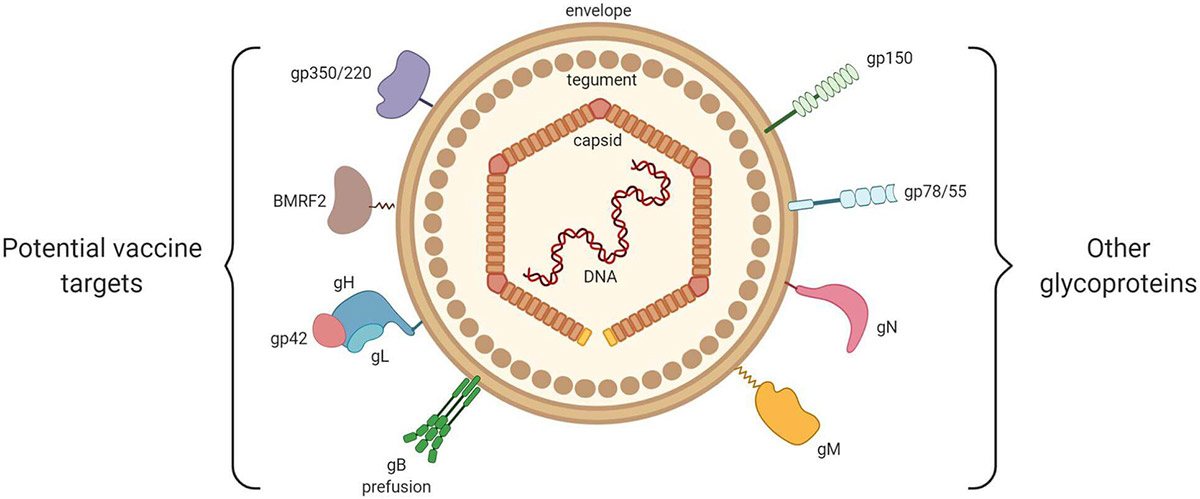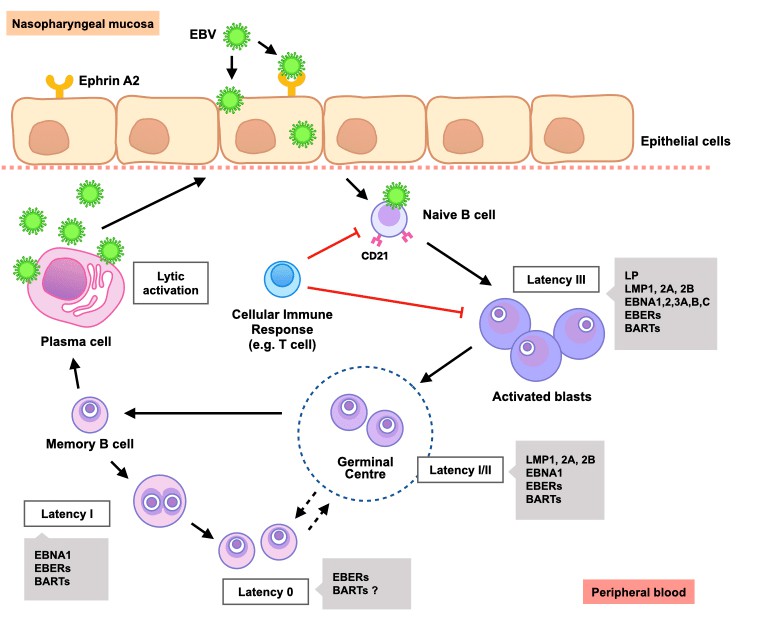The Epstein–Barr virus (EBV), formally called Human gammaherpesvirus 4, is one of the nine known human herpesvirus types in the herpes family, and is one of the most common viruses in humans. EBV is classified in the family Herpesviridae, subfamily Gamaherpesvirinae, genus Lymphocryptovirus. It is best known as the cause of infectious mononucleosis (“mono” or “glandular fever”). It is also associated with various non-malignant, premalignant, and malignant Epstein–Barr virus-associated lymphoproliferative diseases and, based on some evidence, higher risks of developing certain autoimmune diseases. About 200,000 cancer cases globally per year are thought to be attributable to EBV. In 2022, a large study (population of 10 million over 20 years) suggested EBV as the leading cause of multiple sclerosis, with a recent EBV infection causing a 32-fold increase in the risk of developing multiple sclerosis.
EBV has a double-stranded DNA genome of 184-kb pairs in length, encoding nearly 100 proteins. The DNA is surrounded by a protein nucleocapsid, which is surrounded by a tegument made of protein, which in turn is surrounded by an envelope containing both lipids and surface projections of glycoproteins, which are essential to infection of the host cell. Figure 1 shows the structure of the Epstein–Barr virus.
 Fig. 1 General structure of Epstein–Barr virus1
Fig. 1 General structure of Epstein–Barr virus1
Infection with EBV occurs by the oral transfer of saliva and genital secretions. The host cells of EBV are mainly lymphocytes and epithelial cells. The mechanisms for entering these two cells are different. To enter epithelial cells, viral protein BMRF-2 interacts with cellular β1 integrins. Endocytosis of the virus into vesicles and fusion of the virus with the vesicle membrane release the nucleocapsid into the cytoplasm. Once the viral nucleocapsid is dissolved, EBV infects oral epithelial cells with viral replication, cell lysis, and release of virions that spread to contiguous structures, including the salivary glands. Local replication in oral epithelial and lymphoid cells may be the basis of the symptoms of pharyngitis. While to enter B cells, viral glycoprotein gp350 binds to cellular receptor CD21 (also known as CR2). Viremia ensues, with infection of the primary cellular target of EBV, the B-lymphocytes in the peripheral blood and the entire lymphoreticular system, including the liver and spleen. In B cells, lytic replication normally only takes place after reactivation from latency; some latently infected B-lymphocytes enter the viral replicative, or lytic, cycle that begins with EBV early antigens (EAs) production; proceeds to viral DNA replication followed by structural glycoprotein production, including the manufacture of viral capsid antigens (VCAs); and culminates in cell death with release of mature virions that are shed through secretions and systemically infect other B-lymphocytes. Reactivation apparently is asymptomatic.
 Fig. 2 Life cycle of EBV2
Fig. 2 Life cycle of EBV2
References
- Jean-Pierre V, Lupo J, Buisson M, et al. (2021). Main Targets of Interest for the Development of a Prophylactic or Therapeutic Epstein-Barr Virus Vaccine. Frontiers in Microbiology,12:701611.
- Richardo T, Prattapong P, Ngernsombat C, et al. (2020). Epstein-Barr Virus Mediated Signaling in Nasopharyngeal Carcinoma Carcinogenesis. Cancers (Basel), 12(9):2441.
